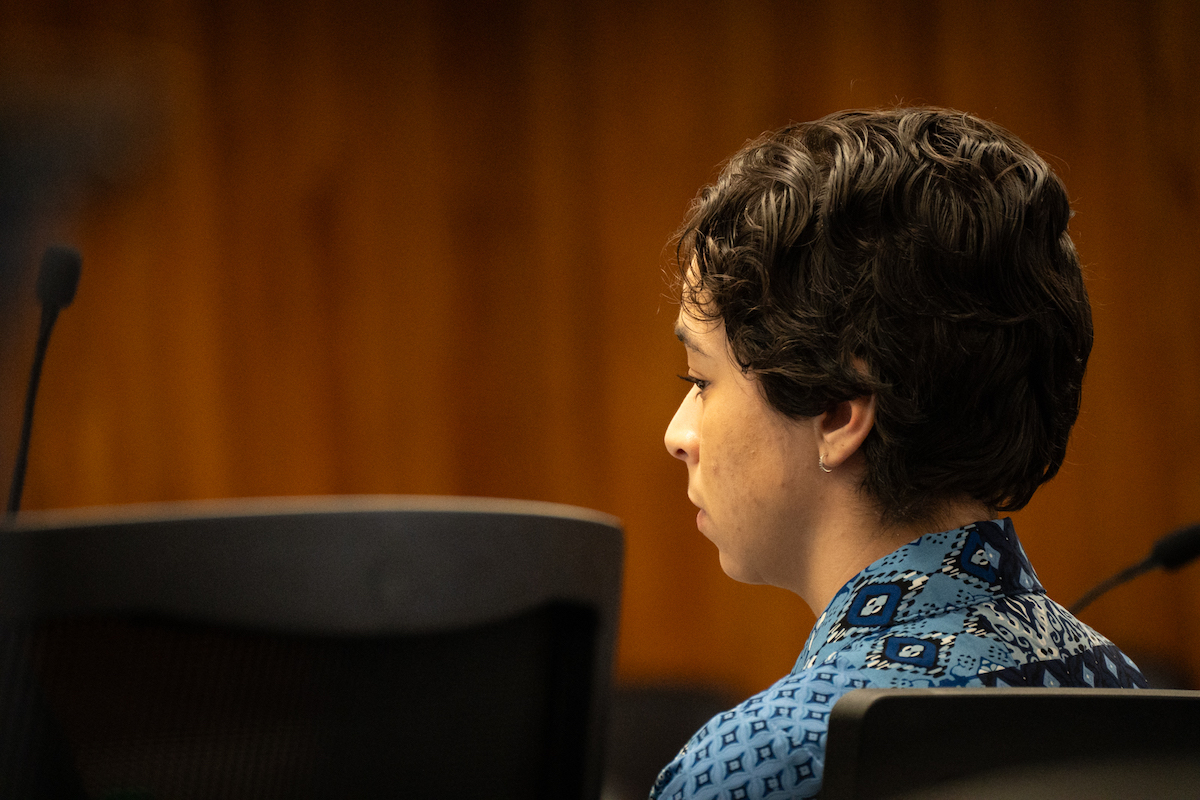Santa Barbara Jury Out on Whether to Send Cora Vides to Prison or Psych Hospital
Closing Arguments Conclude Sanity Phase of Attempted Murder Trial

After hearing from six mental-health professionals, the jury is out on whether Cora Vides — convicted of attempted murder in the Valentine’s Day stabbing of her Laguna Blanca classmate, Georgia Avery — was sane or insane at the time of the attack. Closing arguments were heard on August 21, and the jury will now ultimately decide whether Vides will serve her sentence behind bars or in a psychiatric facility.
In the sanity phase, it was the defense’s burden to prove that Vides was more likely than not insane at the time of the attack — in other words, that her mental defect made her incapable of understanding the nature and quality of her actions or knowing right from wrong.
The events leading up to Vides’s “psychotic break,” said defense attorney Todd Maybrown, were “the perfect storm.” Vides moved from her home state of Washington to Santa Barbara due to her mother’s ongoing mental health problems, and ended up transferring from Santa Barbara High School to Laguna Blanca after having trouble fitting in. Combined with a new birth control medication, worsening depression, and months of mental decompensation, Vides started to have a “bad feeling.”
Eventually, Vides’s “bad feeling became a fixed delusion,” said Maybrown — one that fixed itself onto Georgia Avery.
Of the six expert witnesses — three retained by the defense, one by the prosecution, and two court-appointed — four concluded that Vides was legally insane at the time of the incident (including one of the court-appointed psychologists). However, most didn’t classify her mental state at the time of the attack as “delusional.”
Dr. Brandon Yakush, a court-appointed forensic psychologist, said that he found no evidence of delusions, but did find evidence of depersonalization and derealization during the incident — commonly known as having an out-of-body experience. “She knew the harm she was causing the victim, but didn’t know she was causing it,” he testified. This dissociative “dream state” led to Dr. Yakush’s conclusion that Vides was legally insane when the attack occurred.
Clinical psychologist Dr. Jamie Rotnofsky wrote two separate reports on Vides’s sanity — one in February 2021 and a new one in February 2024 after being retained by the defense. The first report did not mention dissociation, while the second one stated that Vides had “no power, no volition, [and] no control” over the situation.
Maybrown said that Vides has “extraordinary difficulty understanding what went wrong.” The only reasonable explanation for the attack, he argued, was that Vides thought “some outside force was controlling her.”
“This was set up, planned, and goal-oriented,” prosecutor Kevin Weichbrod argued. “There was no point where she lacked the capacity” to understand the nature and quality of her actions.
After Vides stabbed Avery in the neck, an intense struggle ensued as Vides tried to smother the victim, who did everything in her power to alert Vides’s parents — who were asleep in a different room. Avery grabbed a shoe, thinking it would make noise if she threw it across the room, but Vides took it out of Avery’s hand — an “intentional, willful, deliberate action,” said Weichbrod. “Dissociation and being on autopilot is incongruent” with Vides’s actions, which stopped Avery from getting help, he asserted.
During the struggle, Avery testified that Vides was “making an effort” to look up at the wall instead of at her. The defense and their psychologists concluded that this “blank stare” was indicative of her being in a dissociative state.
“I couldn’t look at her,” Vides said that night while speaking with DA Investigator Eric Davis — a statement showing she “was looking away consciously,” added Weichbrod.
The other court-appointed forensic psychologist, Dr. Roxanne Rassti, worked under Dr. Yakush earlier in her career and has the “utmost respect for him.” However, she made the opposite conclusion, stating that she did not find evidence of dissociation at the time of the event, not mentioning it at all in her report. Symptoms from Vides’s uncontended mental-health diagnoses — depression and anxiety — “wouldn’t impair her sense of reality” to the extent that other witnesses argued. Considering this was the “only circumstance” of such intrusive thoughts, Dr. Rassti concluded that Vides was legally sane at the time of the event.
In closing remarks, Weichbrod noted how “convenient” it was that Vides’s only experience of dissociation was “this one moment.”
The only mental-health expert who spoke to Vides within 48 hours of the attack was Dr. James Tahmisian, whose interview was highly contested during both phases of the trial. Over a video call while Vides was being held on bail, Dr. Tahmisian did not inform Vides that he was a psychologist until after the evaluation, violating an ethical standard of informed consent. Vides also asked three times if she needed her attorney present. Each time, she was told some variation of “That’s your decision,” and the interview moved forward without her counsel.
In the interview, Dr. Tahmisian asked three times if some force could make Vides do something she didn’t want to do. She replied, “I don’t know” every time. Vides also mentioned that she was in jail because she “did a bad thing.” When prompted, she said that she knew it was bad “because I know right from wrong.” Based on this, Dr. Tahmisian concluded that Vides was legally sane at the time of the attack, and showed “no indicators of behavioral disturbance.”
If the jury finds Vides sane, she faces 11 years to life in prison. If found insane, she will serve at least the minimum evaluation period of six months in a psychiatric facility, after which doctors there will determine the length of her stay.
Premier Events
Tue, Jan 14
7:00 PM
Santa Barbara
Lucinda Lane Album-Release Show, at SOhO
Tue, Jan 14
7:30 PM
Santa Barbara
UCSB Arts & Lectures Presents: An Evening with Esther Perel
Wed, Jan 15
5:00 PM
Santa Barbara
Public Meeting Commenting on VSFB SpaceX Launches
Wed, Jan 15
5:30 PM
SANTA BARBARA
California Avocados: A Delicious History
Thu, Jan 16
7:00 PM
Santa Barbara
Panic!: CBS and the 1950s Blacklist
Fri, Jan 17
7:00 PM
Santa Barbara
Baroque: Emergence
Fri, Jan 17
7:00 PM
Santa Barbara
Laguna Blanca Theatre Proudly Presents “Clue”
Fri, Jan 17
7:30 PM
Santa Barbara
Selah Dance Collective to Present “Palermo!”
Sat, Jan 18
10:00 AM
Carpineria
People’s March – Carpinteria
Sat, Jan 18
12:00 PM
Santa Barbara
People’s March – Santa Barbara
Tue, Jan 14 7:00 PM
Santa Barbara
Lucinda Lane Album-Release Show, at SOhO
Tue, Jan 14 7:30 PM
Santa Barbara
UCSB Arts & Lectures Presents: An Evening with Esther Perel
Wed, Jan 15 5:00 PM
Santa Barbara
Public Meeting Commenting on VSFB SpaceX Launches
Wed, Jan 15 5:30 PM
SANTA BARBARA
California Avocados: A Delicious History
Thu, Jan 16 7:00 PM
Santa Barbara
Panic!: CBS and the 1950s Blacklist
Fri, Jan 17 7:00 PM
Santa Barbara
Baroque: Emergence
Fri, Jan 17 7:00 PM
Santa Barbara
Laguna Blanca Theatre Proudly Presents “Clue”
Fri, Jan 17 7:30 PM
Santa Barbara
Selah Dance Collective to Present “Palermo!”
Sat, Jan 18 10:00 AM
Carpineria
People’s March – Carpinteria
Sat, Jan 18 12:00 PM
Santa Barbara



















